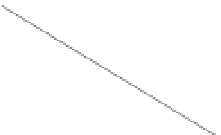Environmental Engineering Reference
In-Depth Information
τ,
q
3
eQUiliBRiUM eQUaTions
3.1
Differential system
The horizontal and vertical balance of forces and
the balance of momentum let to get the following
T
q
τ
σ
3
σ
1
P
,σ
dn
dx
σ
=- ′
στ
y
(1)
ζβ
Mohr´s failure envelope.
Tensorial Criterion.
Hill (1950).
Tensorial Criterion: q = q(p)
dt
dx
=
γ
hy
′-
(
σ
y
′+
τ
)
(2)
dm
dx
Vectorial Criterion:
τ = τ(σ)
=-′
(3)
n y
Figure 2.
Tensorial and vectorial types failure criteria.
where:
- vectorial, coulomb type:
τ
=
τ
(
σ
)
- tensorial, Mohr type:
q
=
q
(
p
). in this case it
is necessary to know the flow rule in plane
deformation to determine the failure plane
and then the stresses acting on it.
t
=
µn
;
m
=
nB
;
h
=
x
-
y
tan
α
being µ a constant.
Basic convention: from now onwards all the
developments will be done adimensionally. To
achieve this the dimensional measuring units in
Table 1 are adopted:
having solved any problem the real results
would have to be obtained by multiplying them by
the respective physical units.
This will give the basic differential system:
σσ σσ
1
−
+
3
1
3
q
=
;
p
=
2
2
Flow rule is:
sin
ψ
= n(sin
ρ
)
dn
dx
=− ′
στ
y
(4)
where
ρ
= angle of instant friction;
ψ
= angle of
dilatancy; n(sinρ) the dilatancy function.
Both failure criteria are related:
dn
dx
+
nd
dx
µ
=−
(
)
′
−
µ
x tg
ασ
y
(
y
′
+
τ
)
(5)
sinρ=
dq
dp
dm
dx
(
)
=− ′
1 µ
yn
(6)
τ =
q
cos
ψ
; σ =
p
-
q
cos
ψ
where q = q(
ρ
) and sin
ψ
= nsin
ρ
.
5. The total pressure on any vertical plane of
the wedge forms a constant δ angle with the
horizontal. This angle is called the earth-
wall-friction angle and is defined by its tangent:
α
α
µ = tanδ
∆
6. The failure surface produces the extremal force
on the wall (maximum and minimum in the
active and passive case respectively).
7. For the maximum force on the wall to be
produced the wall has to be moved away from
the earth while for the minimum the wall has
to be moved towards it. in these situations the
wedge attempts to lower or rise itself and thus
there are established the directions of the reac-
tions on the failure surface of the wedge.
∆
∆
∆
∆
∆
Figure 3.
Forces in a slice.
































































































































































































































































































































































































